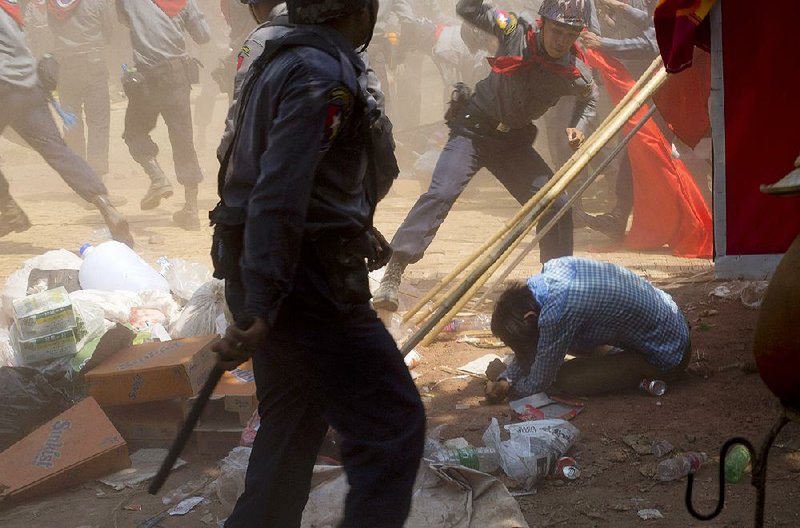LETPADAN, Burma -- Hundreds of riot police charged at students protesting Burma's new education law Tuesday, pummeling them with batons and then dragging them into trucks, bringing a quick, harsh end to a week-long standoff. Authorities said more than 120 people were arrested.
Security forces threw stones and jumped over fences as they broke up the demonstration. Dozens of students and monks were chased into a Buddhist monastery, said Honey Oo, a student leader.
"Many people were beaten and several arrested," she said by telephone.
After the crackdown, police were seen celebrating and shouting, "Victory. Victory."
Information Minister Ye Htut said 127 people, including 65 students, were detained and 16 police and eight demonstrators had been injured.
While there were no reported deaths, Tuesday's violence served as a reminder of Burma's recent days of brutal, authoritarian rule. A European Union delegation that has been training Burma's police in crowd control issued a statement expressing deep concern over the use of force against protesters and calling for a formal investigation.
Burma, is also called Myanmar, a name that ruling military authorities adopted in 1989. Regime opponents refused to adopt the name change, as have the U.S. and Britain.
The current, nominally civilian government installed four years ago has been grappling with the consequences of newfound freedoms of expression. It has been especially sensitive about public protests, arresting hundreds of people since taking office for peacefully expressing their views.
In January, about a hundred students started marching from Burma's second biggest city, Mandalay, to the old capital, Rangoon, to protest a new law that puts all decisions about education policy and curriculum in the hands of a group largely made up of government ministers. Critics said the decision undermines the autonomy of universities.
The demonstrators were joined by monks and other activists, raising their number to about 200 in the past nine days, when they were blocked by police and began a sit-in on a road near a monastery in Letpadan, about 90 miles north of Rangoon.
Early Tuesday, the two sides had appeared close to reaching an agreement.
Police said the students could march to a nearby town and then be transported to Rangoon in government-provided trucks, but they then demanded the protesters refrain from shouting slogans or waving flags.
Hundreds of police wearing helmets and camouflage fatigues formed a human chain several layers deep across the road while setting up barbed-wire barriers. The protesters, many wearing red T-shirts and bandanas, tried to push their way through. Some monks in maroon robes joined the students.
The police then began chasing the protesters with batons and sticks. Associated Press photographers said some protesters were beaten on the head, punched and kicked as they were dragged to the waiting trucks.
Those arrested included two student leaders, Min Thwe Thit and Phyo Phyo Aung.
Burma's government is especially sensitive about protests in Rangoon because the city was the scene of 1988 pro-democracy demonstrations largely led by students and brutally crushed by the former military junta, with an estimated 3,000 people killed.
Similar protests spread across the country, eventually leading to the collapse of the previous 26-year socialist military regime.
In recent days the government has crushed several protests in and around Rangoon, usually by dragging demonstrators into trucks.
A Section on 03/11/2015

